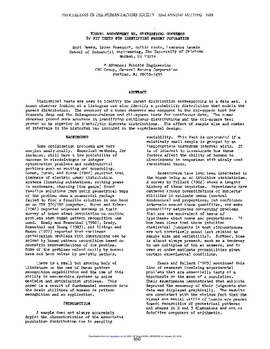| dc.contributor.author | Mari Berry | |
| dc.contributor.author | Brian Peacock | |
| dc.contributor.author | Bobbie Foote | |
| dc.contributor.author | Lawrence Leemis | |
| dc.date.accessioned | 2016-01-14T19:53:49Z | |
| dc.date.accessioned | 2016-03-30T15:35:29Z | |
| dc.date.available | 2016-01-14T19:53:49Z | |
| dc.date.available | 2016-03-30T15:35:29Z | |
| dc.date.issued | 1988-10-01 | |
| dc.identifier.citation | Berry, M., Peacock, B., Foote, B., & Leemis, L. (1988). Visual Assessment vs. Statistical Goodness of Fit Tests for Identifying Parent Population. Proceedings of the Human Factors and Ergonomics Society Annual Meeting, 32(7), 460-464. doi: 10.1177/154193128803200701 | en_US |
| dc.identifier.uri | https://hdl.handle.net/11244/25470 | |
| dc.description.abstract | Statistical tests are used to identify the parent distribution corresponding to a data set. A human observer looking at a histogram can also identify a probability distribution that models the parent distribution. The accuracy of a human observer was compared to the chi-square test for discrete data and the Kolmogorov-Smirnov and chi-square tests for continuous data. The human observer proved more accurate in identifying continuous distributions and the chi-square test proved to be superior in identifying discrete distributions. The effect of sample size and number of intervals in the histogram was included in the experimental design. | en_US |
| dc.language.iso | en_US | en_US |
| dc.publisher | Proceedings of the Human Factors and Ergonomics Society Annual Meeting | |
| dc.title | Visual Assessment vs. Statistical Goodness of Fit Tests for Identifying Parent Population | en_US |
| dc.type | Research Article | en_US |
| dc.description.peerreview | Yes | en_US |
| dc.description.peerreviewnotes | https://us.sagepub.com/en-us/nam/manuscript-submission-guidelines | en_US |
| dc.identifier.doi | 10.1177/154193128803200701 | en_US |
| dc.rights.requestable | false | en_US |
